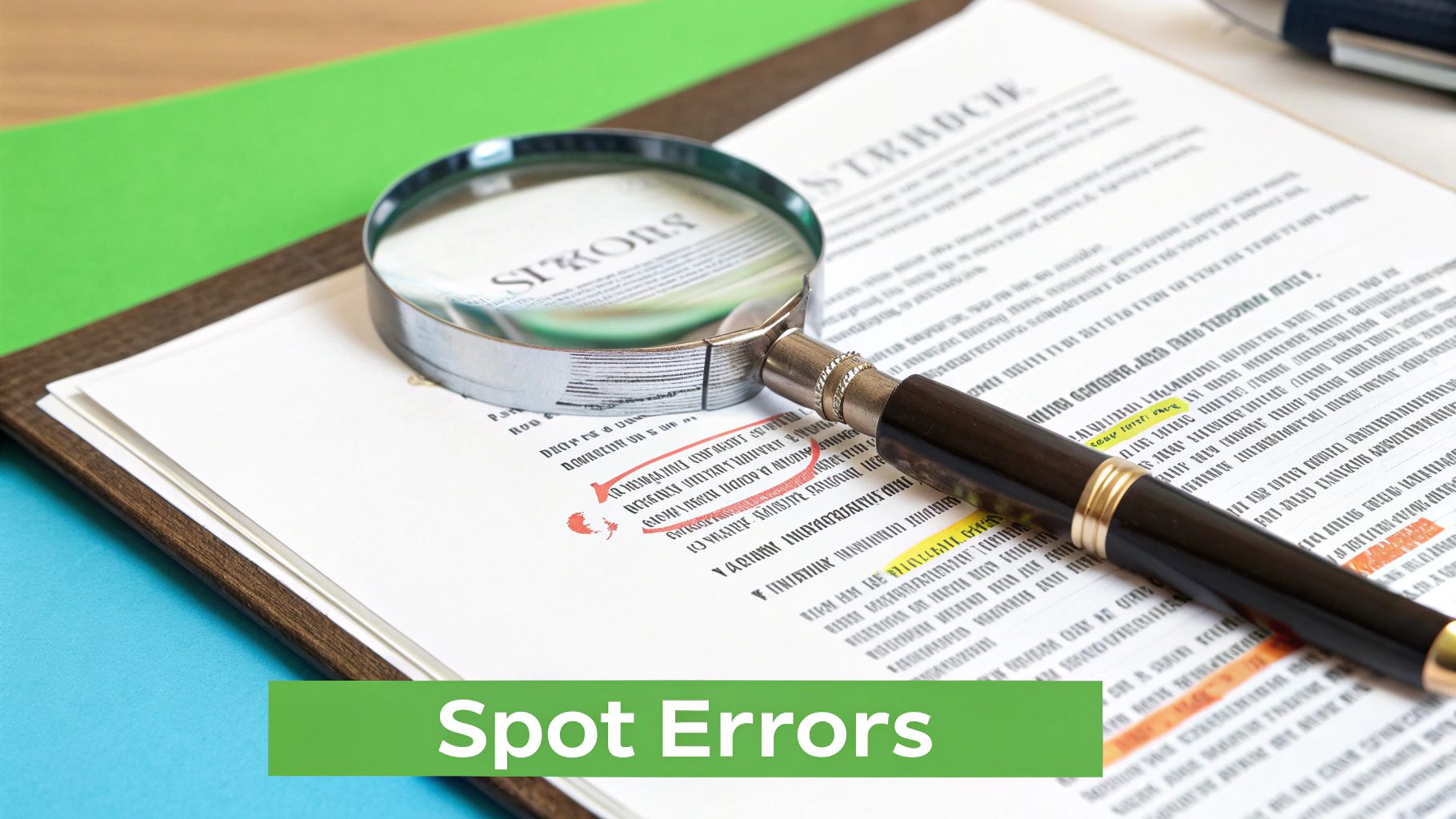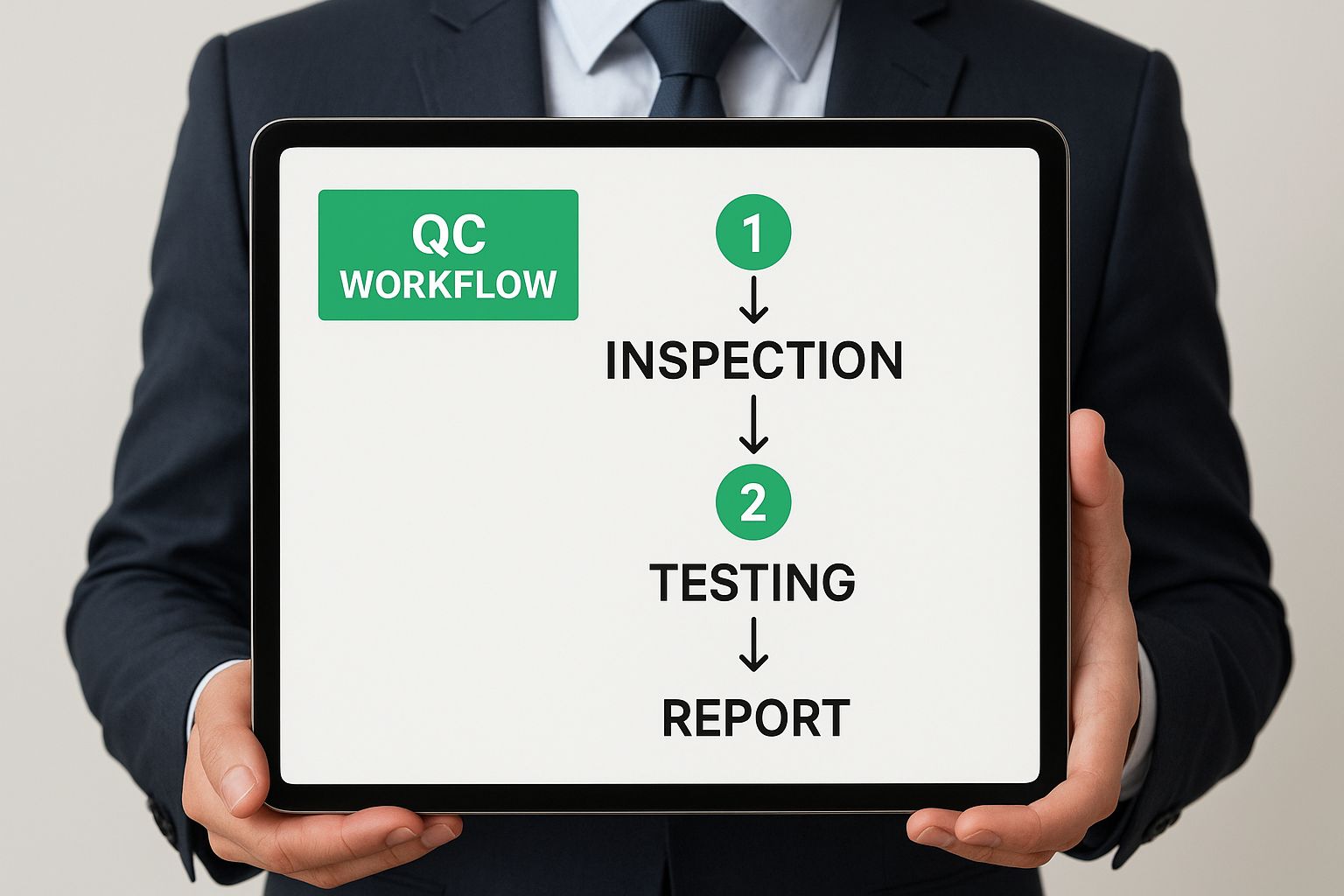Learn to implement robust documentation quality control. Our guide covers metrics, workflows, and tools to ensure accurate, clear, and reliable content.
Documentation quality control is the process of making sure your technical guides, manuals, and support articles are actually accurate, clear, and useful. Think of it like a final inspection on a product’s blueprint. A tiny mistake on paper can lead to a massive failure in the real world, frustrating your users and racking up costs you never saw coming.

It’s easy—and costly—to think of quality control as just a fancy term for proofreading. But it’s a core business function that directly protects your bottom line, brand, and day-to-day operations. When your documentation fails, the ripple effects are felt everywhere.
Confusing or flawed instructions don’t just annoy people; they create real business headaches. Every ambiguous sentence or outright error can become a new support ticket. That means higher operational costs and your best engineers being pulled away from innovation to put out fires. For complex products, the fallout is even worse, leading to improper use, customer churn, and a damaged reputation.
A solid quality control process is built on a few fundamental pillars. Each one is essential for creating documentation that works for your users and your business. Getting them right creates a seamless, effective experience that makes your product shine.
Here’s a breakdown of what a great quality process aims to deliver.
These pillars don’t exist in a vacuum; they work together to build trust and empower users.
Beyond keeping users happy, a systematic approach to quality is a powerful risk management tool. In regulated industries, bad documentation isn’t just an inconvenience—it’s a compliance failure that can trigger serious penalties.
This is a stark reminder that documentation isn’t just about the product; it is part of the product. Investing in its quality is a direct investment in safety, compliance, and financial stability, protecting your business from preventable and expensive disasters.

To make your documentation quality control truly effective, you have to move beyond gut feelings. You can’t improve what you don’t measure. Relying on instinct to tell you if content is “good” just doesn’t work; you need real data to find weak spots, justify spending time and money, and prove that your quality efforts are paying off.
Think of it like a doctor trying to figure out what’s wrong with a patient. They don’t just guess. They run specific tests—blood pressure, temperature, X-rays—to get a clear picture. In the same way, great documentation measurement uses a mix of hard numbers (quantitative) and user feedback (qualitative) to understand its overall health.
Quantitative metrics give you the hard data you can track over time. These numbers are your first line of defense, offering an objective look at your documentation’s basic health and clarity. They’re fantastic for spotting trends and flagging areas that need help right away.
Here are a few essential numbers to keep an eye on:
These numbers give you a solid baseline. For example, if you see that new articles always launch with a high defect density, that points to a problem in your creation and review workflow. Pushing to improve readability scores across your whole knowledge base becomes a concrete, measurable goal for your team.
Numbers are vital, but they don’t paint the full picture. Qualitative metrics help you understand the why behind the data. They capture how users actually feel and whether the documentation solved their real-world problems.
Getting good qualitative feedback means creating feedback loops, both direct and indirect:
When you combine these quantitative and qualitative methods, you build a powerful system for your documentation quality control. The data tells you what’s wrong, and the user feedback tells you why. This complete view allows you to make focused, meaningful improvements that make a real difference to your users.
Let’s be honest: a solid documentation quality control process doesn’t just happen. You can’t just hope for the best. Quality isn’t about a single heroic editor swooping in at the last minute to catch every mistake. Instead, it’s a deliberately designed, multi-stage system where each step adds another layer of polish and validation.
Think of it like an assembly line in a factory. Each station has one specific job—add a part, tighten a screw, run a quick diagnostic. By the time a product gets to the end of the line, it’s passed through multiple checkpoints, guaranteeing its quality. Your documentation workflow should operate on the very same principle.
This simple flowchart shows how a QC workflow can be broken down into distinct, manageable stages.

As you can see, a robust process moves content from creation through several review layers before it ever sees the light of day.
Everything starts with the author. This person is usually a technical writer, developer, or product manager—whoever holds the original knowledge. Their primary job is to get all the core information down, focusing first and foremost on technical accuracy and completeness.
This isn’t the time to obsess over perfection. The goal is to translate that expert knowledge into a structured document that answers the user’s main questions: What is this thing? How do I use it? What are the exact steps I need to follow?
Once the first draft is ready, it’s time for a peer review. This is a critical collaborative step. Another writer or a fellow team member takes a look, acting as the first line of defense to catch issues the original author might have missed.
The peer reviewer is looking for specific things:
This fresh set of eyes is invaluable for spotting awkward phrasing or confusing explanations that the author, who is too close to the subject, might have completely overlooked.
After the peer review cleans up the language and flow, the document is ready for technical validation. This is where a Subject Matter Expert (SME), often the engineer who actually built the feature, rigorously tests the document’s accuracy.
The SME isn’t there to check grammar or style. Their one and only mission is to confirm that the instructions are 100% technically correct and deliver the promised result. They will follow the steps exactly as written to make sure nothing is wrong, misleading, or out of date. This is a crucial quality gate—a single technical error can make an entire article useless, or worse, cause real problems for the user.
With technical accuracy locked in, the document comes back for one last polish. This final check is for catching any lingering typos or formatting weirdness that might have crept in during all the back-and-forth.
Once that’s done, a designated owner—like a documentation manager or team lead—gives the final sign-off for publication.
To really nail this, you’ll want to master some fundamental process documentation best practices. Implementing this multi-stage workflow transforms quality control from a chaotic, last-minute scramble into a predictable, reliable process that consistently produces documentation you can be proud of.
The review stage is the final hurdle in your documentation quality control process, but it’s often where everything grinds to a halt. When feedback is vague, or when reviewers are asked to check everything at once, the whole process becomes a frustrating mess. The solution isn’t to review harder; it’s to review smarter.
Think of it like editing a movie. You wouldn’t ask one person to check sound, visuals, and story pacing all in a single viewing. You’d miss too much. The same goes for documentation—a focused, structured approach turns this bottleneck into a seriously productive part of your workflow.
Here’s the single best thing you can do to improve review quality: stop asking one person to check everything. It just doesn’t work. A subject matter expert deep in the weeds of a technical procedure is the last person who will spot a misplaced comma.
Instead, break the review down into separate, focused passes:
When you separate these concerns, you let each reviewer focus on what they do best. This layered approach catches both the tiny details and the big-picture issues, resulting in a much stronger final document.
Nothing stops progress faster than vague feedback. Comments like “this is confusing” or “I don’t like this” are dead ends. They leave the writer guessing and can feel more like a personal attack than helpful input. To make reviews work, all feedback needs to be specific, actionable, and objective.
So, instead of saying, “The introduction is weak,” try this: “The introduction should state who this feature is for and what problem it solves within the first two sentences.” See the difference? Now the author has a clear task. This is the same principle that makes a good code review effective, where precision is everything. You can learn more from this handy checklist for effective code reviews.
Not all reviews are the same, and the method you pick should match the document and your team’s rhythm. Two of the most common and effective approaches are pair writing and asynchronous feedback.
Pair writing is fantastic for getting things right the first time, cutting the feedback loop down to seconds. Asynchronous reviews, on the other hand, give people the space to provide more thoughtful, detailed feedback without the pressure of a live meeting. A smart mix of both can seriously level up your entire documentation quality control process.
Let’s be honest, manual checks are a vital part of any serious documentation quality control process. But they can only get you so far. If you’re relying on your team to manually catch every single typo, broken link, and formatting mistake, you’re not just moving slowly—you’re misusing their talent.
This is where automation and AI completely change the game.
The goal isn’t to replace your expert reviewers. It’s to supercharge them. By offloading the tedious, mind-numbing tasks to an automated tool, you free up your team to focus on what humans do best: judging clarity, verifying technical accuracy, and thinking critically about the end-user’s experience.
The easiest place to start with automation is tackling the simple, rule-based checks that eat up so much review time. An automated tool can zip through thousands of pages in seconds, flagging issues a human reviewer would almost certainly miss after a few hours of staring at a screen.
Think about the usual suspects:
When you automate these basics, you can be sure that any document landing on a human reviewer’s desk is already polished. They can dive straight into the substance of the content. This is a massive win, especially for technical content like developer guides. You can dig deeper into this in our guide to automated code documentation.
But automation doesn’t stop at spelling and grammar. The next leap forward is Intelligent Document Processing (IDP). IDP uses AI not just to read text, but to actually understand and validate the information inside. For instance, it can automatically cross-reference an invoice with a purchase order to ensure the numbers match, or check that a new safety guide aligns with your master compliance documents.
This kind of intelligent automation is a much deeper layer of quality control, moving beyond surface-level checks to verify the actual integrity of your information.
Automation can even help make sure your documentation gets seen in the first place. Exploring strategies for faster indexing is a smart move to ensure your fresh or updated content shows up in search results without delay.
So, where do you draw the line? The most effective approach is a hybrid one where automation handles the grunt work and humans provide the strategic oversight. A robust documentation quality control workflow knows the strengths of both and assigns tasks accordingly. Getting this balance right is the secret to a truly efficient process.
To make it tangible, here’s a look at which quality checks are better left to humans and which are perfect for automation.
By intelligently dividing the labor, you create a system that’s both faster and more thorough. You’ll catch a much wider range of issues before they ever reach your customers, freeing up your team to do the high-value strategic work that no machine can replicate.
Jumping into documentation quality control can feel like opening a can of worms. You know it’s important, but where do you even start? Here are some of the most common questions we see, along with practical answers to get you on the right track.